The Impact of a Mobile Laboratory on Water Quality Assessment in Remote Areas of Panama
Abstract
1. Introduction
2. Materials and Methods
2.1. Laboratory Deployment
2.2. Pilot Study: Tonosí District
2.3. Environmental, Social, and Economic Impacts
2.4. Strengths, Weaknesses, Opportunities, and Threats (SWOT) Analysis
3. Results
3.1. Air Quality, Microbiological, and Fire Safety Equipment in the Mobile Laboratory
3.1.1. Air Quality Monitor
3.1.2. Air Purification System
3.1.3. Volatile Organic Contaminant Detector
3.1.4. ATP Luminometer
3.1.5. Laboratory Fume Hood
3.1.6. Fire Safety Equipment
3.2. Furniture
3.3. Water Supply and Collection System
3.4. Power Supply System
3.5. Specialized Equipment for Water Quality Analysis
3.6. Auxiliary Equipment for Water Quality Analysis
3.7. Mobile Laboratory Applications for Water Quality Assessment
3.7.1. Parameters That Can Be Analyzed Using the Mobile Laboratory
- Reglamento Técnico DGNTI-COPANIT 21-2019 “Tecnología de los alimentos agua potable definiciones y Requisitos generales” of Panama [22].
- National Primary Drinking Water Regulations (Environmental Protection Agency) of the United States [57].
- Directive (UE) 2020/2184 on the quality of water intended for human consumption of the European Union [58].
3.7.2. Technical Evaluation of the Analytical Equipment
3.7.3. Geographical Scope Due to the Possibility of Transportation
3.7.4. Trained Human Resources
- Theoretical-practical course on the implementation of environmental analysis, good operating practices, and interpretation of results of the Torion T-9 portable GC-MS system;
- Luminometry training in the use of adenosine trisphosphate test, and SureTrend cloud system 4.0;
- Training in instrumentation for water analysis (use of HACH equipment);
- Training on the use and characteristics of auxiliary equipment for environmental laboratories;
- Training in basic sample preparation for the S2 PICOFOX equipment and use of the Spectra 7.8.2.0 software.
3.8. Pilot Study: Tonosí District
3.9. Environmental, Social, and Economic Impacts
3.9.1. Link to the Sustainable Development Goals
3.9.2. Link to the Water Security Plan of Panama
- Target N° 1: Universal access to quality water and sanitation services.
- Target N° 2: Water for inclusive socio-economic growth.
- Target N° 3: Preventive management of water-related risks.
- Target N° 4: Healthy watersheds.
- Target N° 5: Water sustainability.
3.9.3. Link to Plan for the Development of Science, Technology, and Innovation
- Innovation in water and the environment
- 2.
- Promotion of scientific research and experimental development
- 3.
- Consolidating innovation and collaboration
3.9.4. Lines of Research Related to UTECH
- Sanitation
- Hydrology and Hydrogeology
- Food Safety
- Agroindustry Prospecting
- Food Processing and Analysis
- Agro-industrial Technology
- Agro-industrial Waste Utilization
- Food Technology
- Irrigation and Drainage
- Climate Change
- Maritime and Port Engineering
3.9.5. List of Research Related to UTECH
- Characterization of the heavy metal resistome of the microbiota present in the water sources that supply the rural aqueducts of the district of Tonosí, province of Los Santos, Republic of Panama;
- Use of portable chromatographic techniques for the detection of persistent pollutants in the environment;
- Evaluation and optimization of the total reflection X-ray fluorescence technique for the determination of heavy metals in water for human consumption;
- Radon present status in the Dry Arc of Panama;
- Chemical and mineralogical characterization of hot springs with potential for tourism development in Panama;
- Determination of the chemical profile of the aromas of Panama coffee, using advanced analytical techniques;
- Diagnosis of coastal areas for the reporting of SDG 14 indicators (life below water);
- Evaluation of the origin of heavy metals in the sediments of La Marinera beach, Tonosí, and their influence on the marine ecosystem.
3.9.6. Community Awareness
3.10. Strengths, Weaknesses, Opportunities, and Threats (SWOT)
4. Discussion
5. Conclusions
Author Contributions
Funding
Institutional Review Board Statement
Informed Consent Statement
Data Availability Statement
Acknowledgments
Conflicts of Interest
Appendix A
| TNS-01 | TNS-02 | TNS-03 | ||||||||||
|---|---|---|---|---|---|---|---|---|---|---|---|---|
| Min. | Max. | Mean | SD | Min. | Max. | Mean | SD | Min. | Max. | Mean | SD | |
| pH | 6.97 | 7.51 | 7.30 | 0.23 | 6.98 | 7.30 | 7.19 | 0.14 | 6.90 | 7.13 | 7.05 | 0.11 |
| Conductivity (µs/cm) | 873.00 | 931.00 | 888.75 | 28.27 | 520.00 | 666.00 | 570.75 | 67.46 | 561.00 | 939.00 | 683.50 | 172.69 |
| Total dissolved solids (mg/L) | 398.00 | 415.00 | 403.75 | 8.02 | 226.00 | 301.00 | 253.75 | 34.57 | 252.00 | 417.00 | 307.50 | 74.36 |
| Color (Pt/Co) | 2.00 | 19.00 | 6.75 | 8.22 | 1.00 | 4.00 | 2.00 | 1.41 | 0.00 | 1.00 | 0.50 | 0.58 |
| Turbidity (NTU) | 0.25 | 2.04 | 0.87 | 0.84 | 0.17 | 7.29 | 2.02 | 3.51 | 0.11 | 2.55 | 0.83 | 1.16 |
| Free residual chlorine (mg/L) | 0.01 | 0.15 | 0.06 | 0.06 | 0.00 | 0.02 | 0.01 | 0.01 | 0.01 | 0.20 | 0.06 | 0.09 |
| Nitrate (mg/L) | 0.80 | 5.00 | 2.23 | 2.40 | 0.20 | 5.00 | 2.00 | 2.62 | 0.40 | 0.90 | 0.65 | 0.35 |
| Nitrite (mg/L) | 0.00 | 0.00 | 0.00 | 0.00 | 0.00 | 0.02 | 0.01 | 0.01 | 0.00 | 0.00 | 0.00 | 0.00 |
| Sulphate (mg/L) | 28.00 | 36.00 | 31.67 | 4.04 | 2.00 | 5.00 | 3.33 | 1.53 | 4.00 | 8.00 | 6.33 | 2.08 |
| Chloride (mg/L) | 7.20 | 27.20 | 18.13 | 10.13 | 3.20 | 8.40 | 6.10 | 2.65 | 5.60 | 9.60 | 7.07 | 2.20 |
| Hardness (mg/L) | 310.00 | 460.00 | 385.50 | 62.30 | 180.00 | 260.00 | 225.45 | 35.20 | 282.00 | 460.00 | 342.00 | 102.20 |
| Chromium Cr (mg/L) | 0.01 | 0.14 | 0.08 | 0.06 | 0.01 | 0.65 | 0.28 | 0.27 | 0.02 | 0.41 | 0.22 | 0.16 |
| Iron Fe (mg/L) | 0.03 | 2.00 | 1.21 | 0.84 | 0.04 | 8.08 | 3.32 | 3.71 | 0.05 | 8.38 | 3.49 | 3.90 |
| Antimony Sb (mg/L) | 0.27 | 6.89 | 2.30 | 3.09 | 0.13 | 4.31 | 2.33 | 1.72 | 0.53 | 4.48 | 3.09 | 1.85 |
| Barium Ba (mg/L) | 0.02 | 0.68 | 0.30 | 0.29 | 0.01 | 2.19 | 0.76 | 0.97 | 0.03 | 1.64 | 0.79 | 0.69 |
| Nickel Ni (mg/L) | 0.00 | 0.05 | 0.03 | 0.02 | 0.07 | 0.18 | 0.11 | 0.07 | 0.01 | 0.13 | 0.09 | 0.05 |
| Copper Cu (mg/L) | 0.01 | 0.15 | 0.07 | 0.06 | 0.01 | 12.20 | 3.12 | 6.05 | 0.13 | 0.33 | 0.23 | 0.10 |
| Zinc Zn (mg/L) | 0.02 | 0.14 | 0.06 | 0.05 | 0.04 | 8.21 | 2.81 | 4.67 | 0.04 | 0.38 | 0.26 | 0.19 |
| Manganese Mn (mg/L) | 0.23 | 1.73 | 0.98 | 0.62 | 0.06 | 0.11 | 0.09 | 0.04 | 0.10 | 0.38 | 0.29 | 0.16 |
References
- Balaram, V. New Frontiers in Analytical Techniques—Opportunities and Challenges in Geochemical Research. J. Geol. Soc. India 2021, 97, 331–334. [Google Scholar] [CrossRef]
- Sajid, M.; Płotka-Wasylka, J. Green Analytical Chemistry Metrics: A Review. Talanta 2022, 238, 123046. [Google Scholar] [CrossRef]
- Comité de Alto Nivel de Seguridad Hídrica. Plan Nacional de Seguridad Hídrica 2015–2050: Agua Para Todos; Consejo Nacional del Agua: Panama City, Panama, 2016. [Google Scholar]
- Consejo de la Concertación Nacional para el Desarrollo. Plan Estratégico Nacional Con Visión de Estado ODS Panamá 2030; Consejo de la Concertación Nacional para el Desarrollo: Panama City, Panama, 2017; ISBN 978-9962-663-33-1. [Google Scholar]
- Syngellakis, S.; Melgarejo, J. Urban Growth and the Circular Economy; WIT Press: Southampton, UK, 2018; ISBN 978-1-78466-259-2. [Google Scholar]
- Li, P. To Make the Water Safer. Expo. Health 2020, 12, 337–342. [Google Scholar] [CrossRef]
- Mambretti, S.; Proverbs, D. Urban Water Systems & Floods IV; WIT Press: Southampton, UK, 2022; ISBN 978-1-78466-469-5. [Google Scholar]
- Him Fábrega, J.J.; Arena Camargo, E.; Bósquez Otero, K. Calidad Fisico-Química y Microbiologíca Del Agua Del Río Santa María En Las Inmediaciones Del Reservorio de Agua Del Acueducto de Santiago, Veraguas. Tecnociencia 2019, 21, 13–30. [Google Scholar]
- Frías, G.; Cristina, M. Estudio de la Calidad del Agua en la Planta Potabilizadora que Abastece a la Comunidad de Macaracas Cabecera, Provincia de Los Santos. Bachelor’s Thesis, Universidad Especializada de las Américas, Panama City, Panama, 2020. [Google Scholar]
- Meneses Sánchez, J.L. Calidad del agua en la microcuenca Los Hules—Tinajones, cuenca del Canal, Panamá. In Water Quality in the Los Hules-Tinajones Micro-Watershed; Canal Watershed: Panama City, Panama, 2003. [Google Scholar]
- Casado Puente, C. El enfoque de género en los proyectos de agua y saneamiento. Estudio de Caso del Programa de Agua Potable y Saneamiento en Áreas Rurales e Indígenas de Panamá del Fondo de Cooperación al Agua y Saneamiento de la Cooperación Española. Bachelor’s Thesis, Comillas Pontifical University, Madrid, Spain, 2021. [Google Scholar]
- Sosa-Rodriguez, F.S. SDG6 Progress in Latin America and the Caribbean: COVID Pandemic and New Challenges. In SDGs in the Americas and Caribbean Region; Aguilar-Rivera, N., Borsari, B., de Brito, P.R.B., Andrade Guerra, B., Eds.; Springer International Publishing: Cham, Switzerland, 2023; pp. 623–644. ISBN 978-3-031-16017-2. [Google Scholar]
- SENCYT. Plan Estratégico Nacional de Ciencia, Tecnología e Innovación (PENCYT 2019–2024); SENACYT: Panama City, Panama, 2021. [Google Scholar]
- Rao, L.; Lei, J.; Liu, C.; Wan, S.; Zou, G.; Xu, M.; Yang, R. Multi-Functional Water Quality Testing Car. 2016. Available online: https://worldwide.espacenet.com/publicationDetails/description?CC=CN&NR=204978367U&KC=U&FT=D&ND=3&date=20160120&DB=EPODOC&locale= (accessed on 15 July 2024).
- Zhang, Q.; Liang, T.; Niu, H.; Li, L.; Gong, D.; Zhang, Z. Urban Water Supply Water Quality Monitoring Movable Laboratory. 2018. Available online: https://worldwide.espacenet.com/publicationDetails/description?CC=CN&NR=208109827U&KC=U&FT=D&ND=3&date=20181116&DB=EPODOC&locale= (accessed on 15 July 2024).
- Acharya, K.; Blackburn, A.; Mohammed, J.; Haile, A.T.; Hiruy, A.M.; Werner, D. Metagenomic Water Quality Monitoring with a Portable Laboratory. Water Res. 2020, 184, 116112. [Google Scholar] [CrossRef]
- Dewailly, É.; Pereg, D.; Côté, S. Atlantis Mobile Laboratory for Population Survey. Epidemiology 2006, 17, S434. [Google Scholar] [CrossRef]
- Maheux, A.F.; Bissonnette, L.; Huppé, V.; Boissinot, M.; Bergeron, M.G.; Dewailly, É. The Requirements and Challenges of a Mobile Laboratory for Onsite Water Microbiology Assessment. Water Pract. Technol. 2016, 11, 198–209. [Google Scholar] [CrossRef]
- Empresas Públicas de Armenia. Laboratorio Móvil Que Garantiza la Calidad del Agua Fue Presentado Ante el Comité de Gerencia de Epa. Available online: https://www.epa.gov.co/todas-las-noticias/10378-laboratorio-movil-que-garantiza-la-calidad-del-agua-fue-presentado-ante-el-comite-de-gerencia-de-epa (accessed on 15 July 2024).
- Universidade Feevale. Brasil y Dinamarca Trabajarán en el desarrollo de un laboratorio Móvil de Calidad del Agua. Available online: https://www.feevale.br/acontece/noticias/brasil-y-dinamarca-trabajaran-en-el-desarrollo-de-un-laboratorio-movil-de-calidad-del-agua (accessed on 15 July 2024).
- Pocasangre, H. Marn Recibe dos Laboratorios Móviles Para Fortalecer el Trabajo de Monitoreo de la Calidad del Agua; Ministerio de Ambiente y Recursos Naturales: Ciudad de Guatemala, Guatemala, 2022. [Google Scholar]
- DGNTI-COPANIT 21-2019; Tecnología de Los Alimentos, Agua Potable, Definiciones y Requisitos Generales. Ministerio de Comercio e Industrias Reglamento Técnico: Panama City, Panama, 2019.
- USEPA. Air Cleaners and Air Filters in the Home. Available online: https://www.epa.gov/indoor-air-quality-iaq/air-cleaners-and-air-filters-home (accessed on 5 December 2024).
- Environmental Protection Agency (EPA). Summary of Available Portable VOC Detection Instruments. Available online: https://nepis.epa.gov/ (accessed on 5 December 2024).
- Hygiena. AquaSnap Total. Available online: https://www.hygiena.com/es/control-de-la-higiene/verificacion-de-la-limpieza-atp/agua-atp/aquasnap-total (accessed on 4 December 2024).
- Hygiena. Lower and Upper RLU Limits for ATP Monitoring Programs: What are Lower and Upper RLU Limits? Available online: https://www.hygiena.com/documents/64166/lower-and-upper-rlu-limits-for-atp-monitoring-programs.pdf?_gl=1*1nepq5u*_up*MQ*_ga*NTQ4NDkxMzk2LjE3MjI1MjI5MDY.*_ga_N1ZFCTH78J*MTcyOTE3NDgwMS4xMTAuMC4xNzI5MTc0ODAxLjYwLjAuMA (accessed on 16 April 2025).
- NFPA45-2024; Standard on Fire Protection for Laboratories Using Chemicals. National Fire Protection Association: Quincy, MA, USA, 2024.
- Stierlin, É.; Michel, T.; Fernandez, X. Field Analyses of Lavender Volatile Organic Compounds: Performance Evaluation of a Portable Gas Chromatography–Mass Spectrometry Device. Phytochem. Anal. 2020, 31, 778–785. [Google Scholar] [CrossRef] [PubMed]
- PerkinElmer. Torion T-9 GC MS. Available online: https://www.perkinelmer.com/library/prd-torion-t-9-portable-gcms.html (accessed on 5 December 2024).
- Towett, E.K.; Shepherd, K.D.; Cadisch, G. Quantification of Total Element Concentrations in Soils Using Total X-Ray Fluorescence Spectroscopy (TXRF). Sci. Total Environ. 2013, 463, 374–388. [Google Scholar] [CrossRef]
- Bruker. S2 PICOFOX. Available online: https://www.bruker.com/en/products-and-solutions/elemental-analyzers/txrf-spectrometers/s2-picofox.html (accessed on 5 December 2024).
- Mekonnen, G.K.; Mengistie, B.; Sahilu, G.; Mulat, W.; Kloos, H. Determinants of Microbiological Quality of Drinking Water in Refugee Camps and Host Communities in Gambella Region, Ethiopia. J. Water Sanit. Hyg. Dev. 2019, 9, 671–682. [Google Scholar] [CrossRef]
- Palintest Potalab + (M) Advanced Portable Water Quality Laboratory (Microbiological). 2011. Available online: https://palinteststaging.halmacloud.com/wp-content/uploads/2025/01/PotalabM_ZI-PTW-10010M-1-compressed.pdf (accessed on 30 October 2024).
- HACH. DR1900 Portable Spectrophotometer. Available online: https://www.hach.com/p-dr1900-portable-spectrophotometer/DR1900-01H (accessed on 30 October 2024).
- Barter, P.J.; Deas, T. Comparison of Portable Nephelometric Turbidimeters on Natural Waters and Effluents. New Zealand J. Mar. Freshw. Res. 2003, 37, 485–492. [Google Scholar] [CrossRef]
- Maldonado, I.; Miranda-Mamani, J.; Paredes-Espinal, C. Heavy Metals and Ecological Alterations Resulting from Wastewater Discharge in Inner Puno Bay, Lake Titicaca. Environ. Nanotechnol. Monit. Manag. 2023, 20, 100903. [Google Scholar] [CrossRef]
- Tokatlı, C. Water Quality of Sultanköy Dam Lake (Ipsala/Edirne): A Preliminary Assessment Study. Int. J. Multidiscip. Stud. Innov. Technol. 2019, 3, 233–235. [Google Scholar]
- HACH. 2100Q Portable Turbidimeter (EPA), 0–1000 NTU. Available online: https://www.hach.com/p-2100q-portable-turbidimeters/2100Q01 (accessed on 30 October 2024).
- HACH. Apparatus Set, DREL 2800 Water Quality Laboratories. Available online: https://www.hach.com/p-apparatus-set-drel-2800-water-quality-laboratories/2923400 (accessed on 30 October 2024).
- Kizito, S.; Lv, T.; Wu, S.; Ajmal, Z.; Luo, H.; Dong, R. Treatment of Anaerobic Digested Effluent in Biochar-Packed Vertical Flow Constructed Wetland Columns: Role of Media and Tidal Operation. Sci. Total Environ. 2017, 592, 197–205. [Google Scholar] [CrossRef]
- Noori, R.; Berndtsson, R.; Hosseinzadeh, M.; Adamowski, J.F.; Abyaneh, M.R. A Critical Review on the Application of the National Sanitation Foundation Water Quality Index. Environ. Pollut. 2019, 244, 575–587. [Google Scholar] [CrossRef]
- Wang, L.; Li, T. Effects of Seasonal Temperature Variation on Nitrification, Anammox Process, and Bacteria Involved in a Pilot-Scale Constructed Wetland. Env. Sci. Pollut. Res. 2015, 22, 3774–3783. [Google Scholar] [CrossRef]
- HACH. BODTrak II Respirometric BOD Apparatus. Available online: https://www.hach.com/p-bodtrak-ii-respirometric-bod-apparatus/2952400 (accessed on 30 October 2024).
- US EPA Method 1664; n-Hexane Extractable Material (HEM; Oil and Grease) and Silica Gel Treated n-Hexane Extractable Material (SGT-HEM; Non-Polar Material) by Extraction and Gravimetry. US EPA: Washington, DC, USA, 2010.
- James, R.R.; Wilbon, P.; DiVincenzo, J.P. Pervious and Impervious Urban Stormwater Runoff in a Rapidly Urbanizing Region: Occurrence of Fluoranthene and Pyrene. Bull. Env. Contam. Toxicol. 2010, 85, 32–36. [Google Scholar] [CrossRef]
- Pardue, M.J.; Castle, J.W.; Rodgers, J.H., Jr.; Huddleston, G.M., III. Effects of Simulated Oilfield Produced Water on Early Seedling Growth After Treatment in a Pilot-Scale Constructed Wetland System. Int. J. Phytoremediation 2015, 17, 330–340. [Google Scholar] [CrossRef] [PubMed]
- Environmental Express Product: Environmental Express StepSaverTM Complete Extraction Systems from Environmental Express. Available online: https://www.environmentalexpress.com/ee/s/product/detail/01t4W00000FjUEfQAN (accessed on 30 October 2024).
- Algretawee, H.; Al-Saadi, R. The Effect of Diurnal and Night Temperatures on Evapotranspiration at an Agricultural Area (Alhusseiniy Area—Karbala City). J. Eng. Sci. Technol. 2023, 18, 2298–2326. [Google Scholar]
- Bustamante-Campoverde, A. Bioclimatic and Energy Performance by Eco-Efficiency in Buildings of the Metropolitan District of Quito, Ecuador. Future Cities Environ. 2024, 10, 1–14. [Google Scholar] [CrossRef]
- Martinez, M.; Bordelon, R.L.; Middleton, B.A.; Villa, J.A.; Kang, H.; Jang, I. Methane Emissions Associated with Bald Cypress Knees Across the Mississippi River Alluvial Valley. Wetlands 2024, 44, 90. [Google Scholar] [CrossRef]
- Parab, T.; De, K.; Singh, A.P.; Uniyal, V.P. Effects of Weather on Behavioural Responses of Two Warbler (Phylloscopus) Species in the Great Himalayan National Park Conservation Area. Ornithol. Res. 2023, 31, 111–118. [Google Scholar] [CrossRef]
- Nielsen-Kellerman Co. Kestrel 5200 Professional Environmental Meter & Anemometer. Available online: https://kestrelinstruments.com/kestrel-5200-professional-environmental-meter (accessed on 30 October 2024).
- OHAUS. Portable Balances. Available online: https://us.ohaus.com/en-us/portable-scales (accessed on 19 November 2024).
- Defe, G.A.; Antonio, A.Z.C. Multi-Parameter Water Quality Monitoring Device for Grouper Aquaculture. In Proceedings of the 2018 IEEE 10th International Conference on Humanoid, Nanotechnology, Information Technology, Communication and Control, Environment and Management (HNICEM), Baguio City, Philippines, 29 November 2018; pp. 1–5. [Google Scholar]
- Tomasko, F. Vacuum Filtration—System and Equipment Technology, Range and Examples of Applications, Designs. In Vacuum Technology in the Chemical Industry; John Wiley & Sons, Ltd.: Hoboken, NJ, USA, 2014; pp. 331–362. ISBN 978-3-527-65389-8. [Google Scholar]
- ISO/IEC 17025; General Requirements for the Competence of Testing and Calibration Laboratories. International Organization for Standardization: Geneva, Switzerland, 2017.
- Environmental Protection Agency. National Primary Drinking Water Regulations. 2024. Available online: https://www.epa.gov/ground-water-and-drinking-water/national-primary-drinking-water-regulations (accessed on 19 November 2024).
- Official Journal of the European Union. DIRECTIVE (EU) 2020/2184 of the European Parliament and of the Council of 16 December 2020 on the Quality of Water Intended for Human Consumption. 2020. Available online: https://eur-lex.europa.eu/eli/dir/2020/2184/oj/eng (accessed on 19 November 2024).
- Gómez Zanetti, N.A.; Olmos Guevara, J.E.; Mack-Vergara, Y.L. Morbidity and Water Quality: A Review with a Case Study in Tonosí, Panama. Water 2024, 16, 2728. [Google Scholar] [CrossRef]
- Henríquez-Rivera, D.; Broce, K.; Olmos, J.; Espinosa, Y. Preliminary Evaluation of the Content of Heavy Metals in Rural Aqueducts of the District of TonosÍ, Province of Los Santos, Panama. In Proceedings of the 2022 8th International Engineering, Sciences and Technology Conference (IESTEC), Panama City, Panama, 19–21 October 2022; pp. 426–431. [Google Scholar]
- Mack-Vergara, Y.; Olmos, J.; Broce, K.; Gómez, N.; Henríquez, D.; Ellis, C.; Espinosa, Y. Resultados y Recomendaciones del Proyecto PFID-INF-2020-48 Morbilidad vs. La Calidad del Aguapara Consumo Humano en Tonosí: Un Estudio Piloto 2025; SENACYT: Panama City, Panama, 2025; ISBN 978-9962-24-494-3. [Google Scholar]
- Mack, Y.; Olmos, J.; Broce, K.; Gómez, N.; Henríquez, D. Evaluación de la calidad del agua para consumo humano por medio de un laboratorio móvil. In Proceedings of the XIX Congreso Nacional de Ciencia y Tecnología–APANAC 2023, Panama City, Panama, 26–29 September 2023; pp. 377–384. [Google Scholar] [CrossRef]
- United Nations. The 17 Goals|Sustainable Development. Available online: https://sdgs.un.org/goals (accessed on 4 December 2024).
- Gonzalez, D. Áreas de Investigación Utp. Available online: https://utp.ac.pa/areas-de-investigacion (accessed on 3 December 2024).
- Dorea, C.C.; Karaulac, T.; Namgyal, K.; Bain, R.; Slaymaker, T.; Johnston, R. Safely Managed Drinking Water Services in the Democratic People’s Republic of Korea: Findings from the 2017 Multiple Indicator Cluster Survey. NPJ Clean Water 2020, 3, 28. [Google Scholar] [CrossRef]
- Montero-Solano, A.I.; Broce, K.; Olmos, J. Influence of Dilution Factors on Detection Capability and Accuracy of Total Reflection X-Ray Fluorescence Analysis of Seawater Samples. In Proceedings of the 2024 9th International Engineering, Sciences and Technology Conference (IESTEC), Panama City, Panama, 23–25 October 2024; pp. 271–274. [Google Scholar]
- Duff, D.; Lennard, C.; Li, Y.; Doyle, C.; Edge, K.J.; Holland, I.; Lothridge, K.; Johnstone, P.; Beylerian, P.; Spikmans, V. Portable Gas Chromatography–Mass Spectrometry Method for the in-Field Screening of Organic Pollutants in Soil and Water at Pollution Incidents. Environ. Sci. Pollut. Res. 2023, 30, 93088–93102. [Google Scholar] [CrossRef]
- de Faria Barbosa, R.; Belo, C.A.D.; da Silva Carneiro, C.; Mársico, E.T. Optimization of Heavy Metal Tracing by Total Reflection X-Ray Fluorescence: The Experts’ Tips. In Chemical Food Contaminants Analysis; Hoff, R., Molognoni, L., Eds.; Springer: New York, NY, USA, 2024; pp. 147–154. ISBN 978-1-07-163806-4. [Google Scholar]
- Chapman, D.V.; Sullivan, T. The Role of Water Quality Monitoring in the Sustainable Use of Ambient Waters. One Earth 2022, 5, 132–137. [Google Scholar] [CrossRef]
- Castillo, M.K.J.; Gómez, Z.N.A.; Olmos, J.; Mack-Vergara, Y.L. Challenges and Opportunities for Sustainable Agriculture in Terms of Pesticides: A Case Study in Tonosí. In Proceedings of the 2024 9th International Engineering, Sciences and Technology Conference (IESTEC), Panama City, Panama, 23–25 October 2024; pp. 158–163. [Google Scholar]
- Guigues, N.; Uysal, E.; Raveau, S.; Magar, J.; Billon, G.; Kahiluoto, J.; Schneider, R.J.; Liv, L.; Gençtürk Tosun, S.; Canteau, G.; et al. Insights on the Validation of Alternative Tools for Water Quality Monitoring: The Case of on-Site Test Kits, Portable Devices and Continuous Measuring Devices. Accred. Qual. Assur. 2024, 29, 163–173. [Google Scholar] [CrossRef]
- Naigaga, S.; Boyd, C.E.; Gaillard, P.; Abdelrahman, H.A.; Molnar, J.J. Assessing the Reliability of Water-Test Kits for Use in Pond Aquaculture. J. World Aquac. Soc. 2017, 48, 555–562. [Google Scholar] [CrossRef]
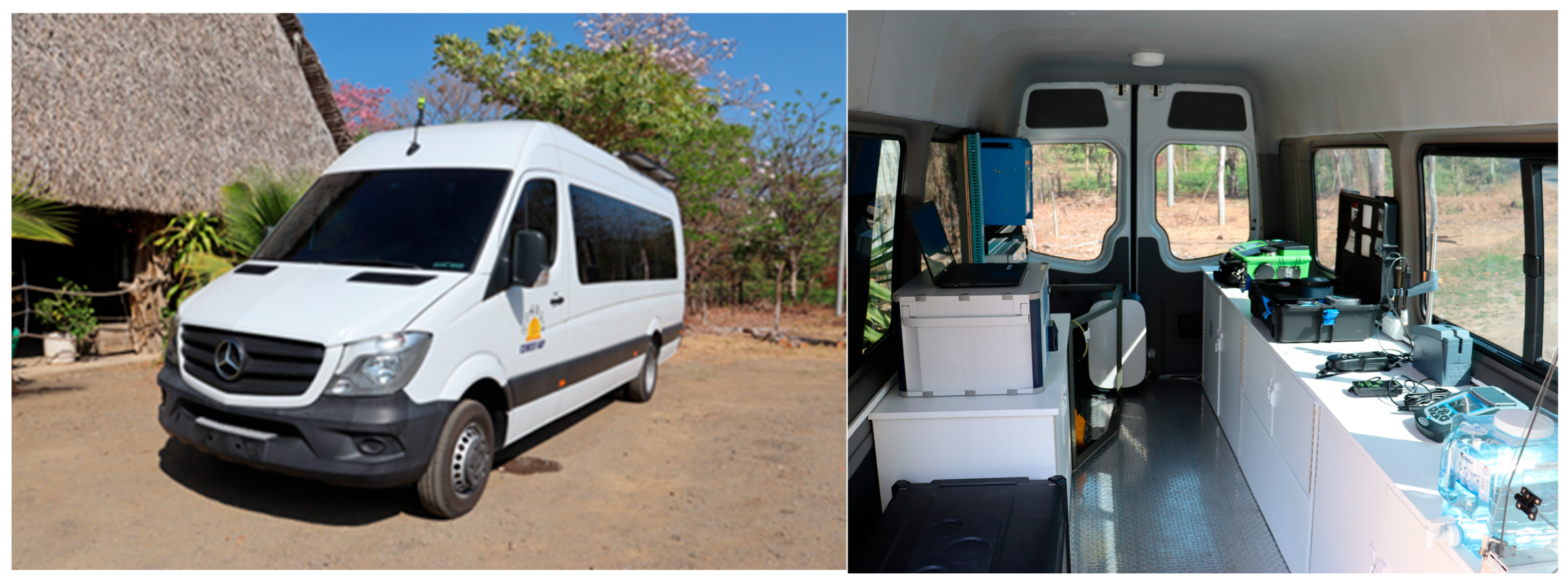
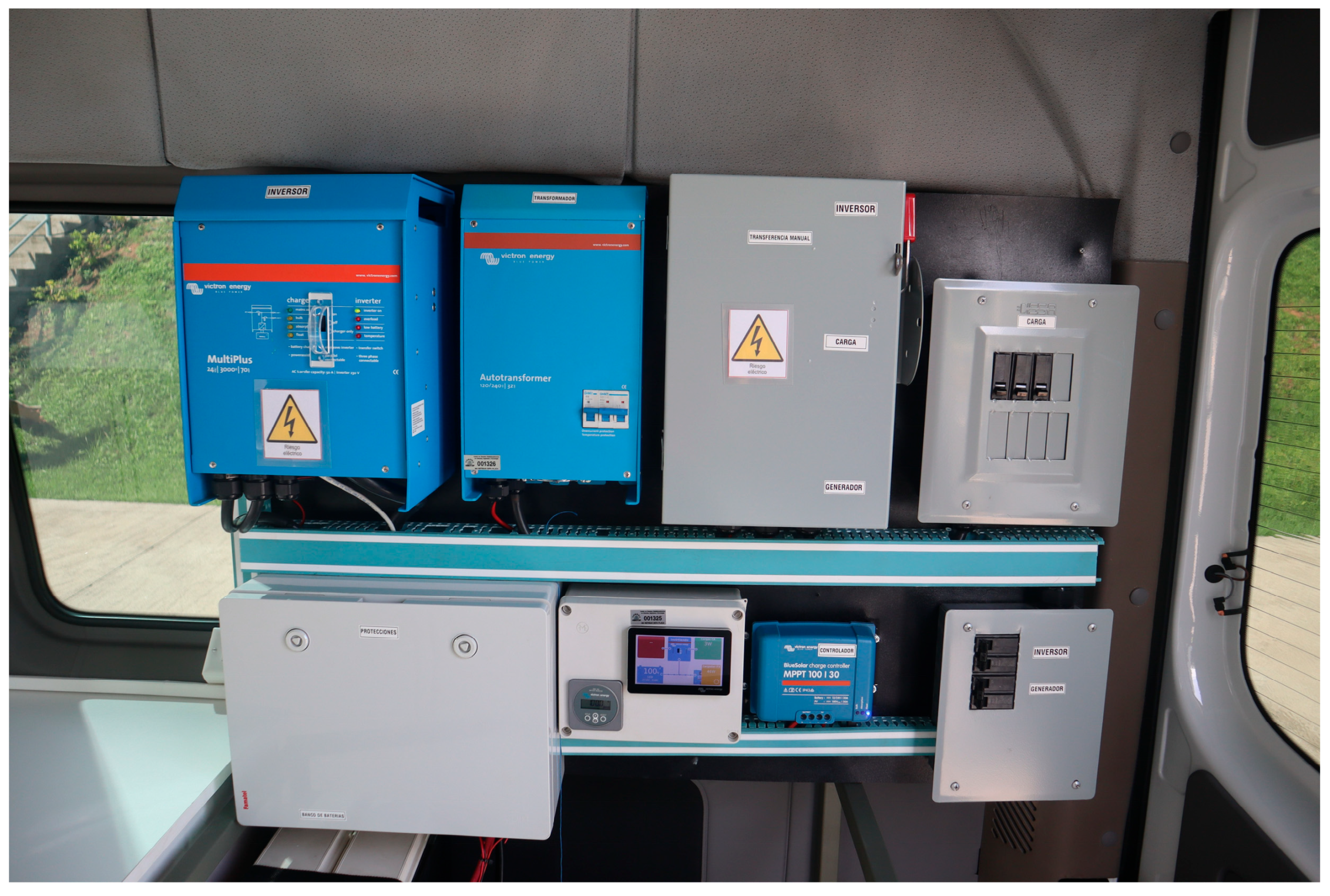
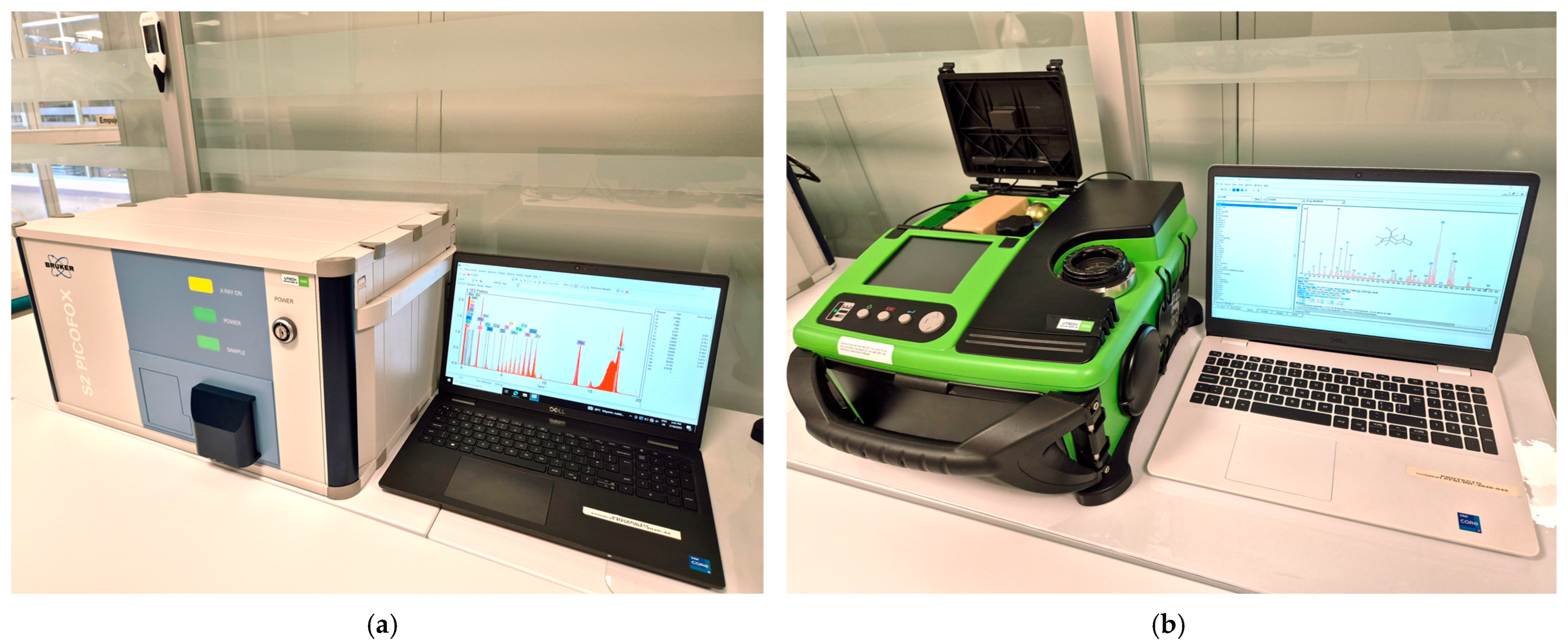
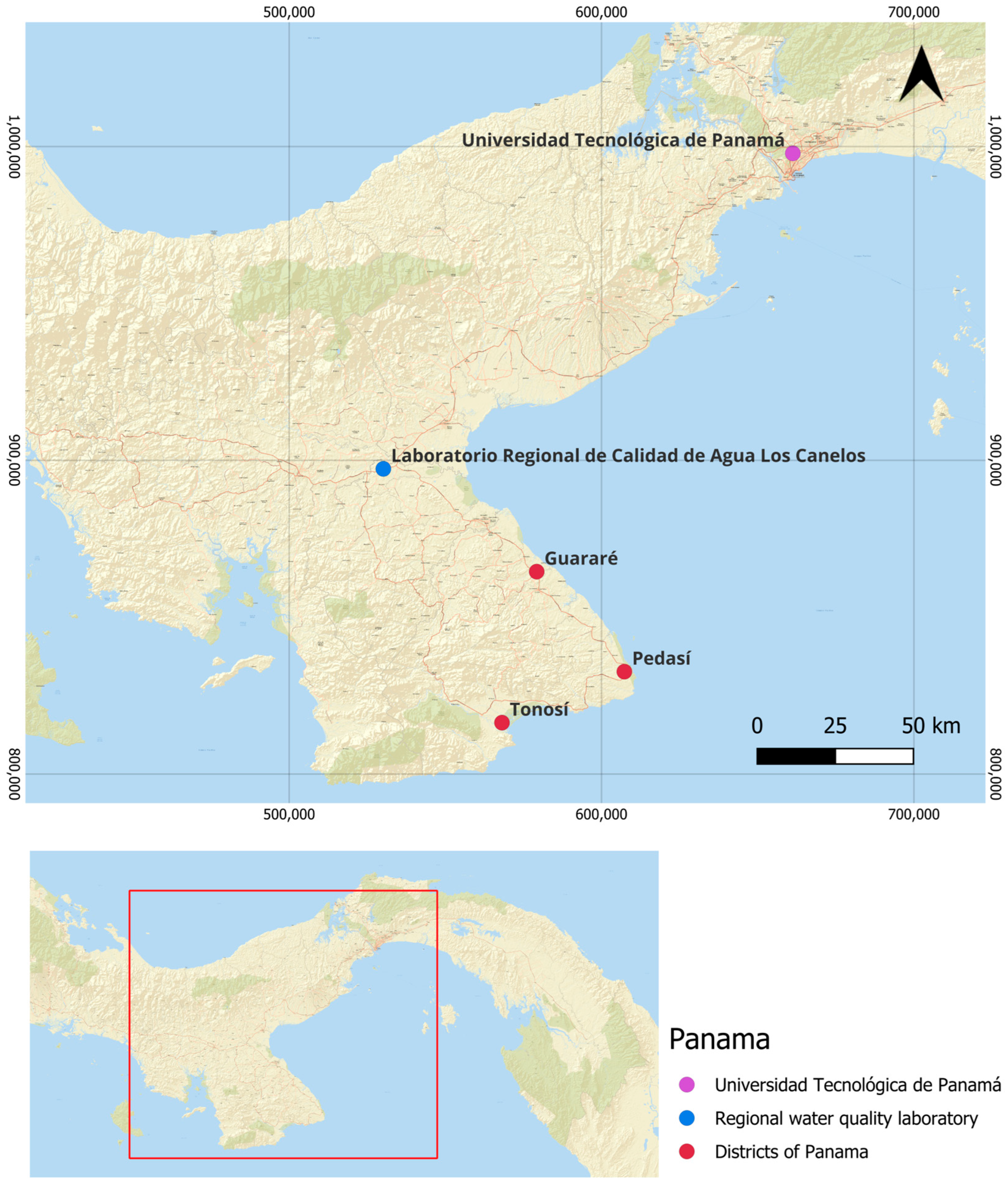
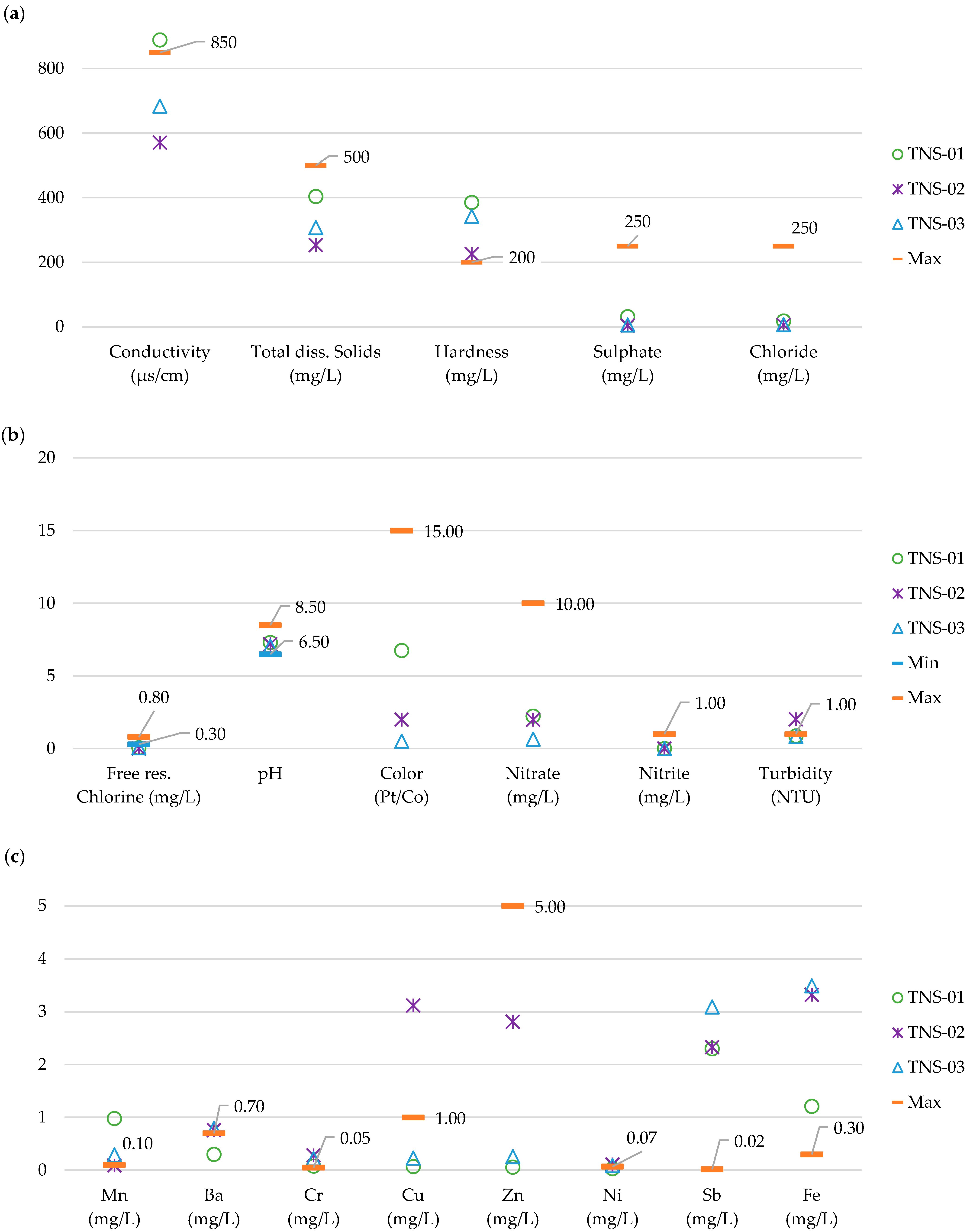
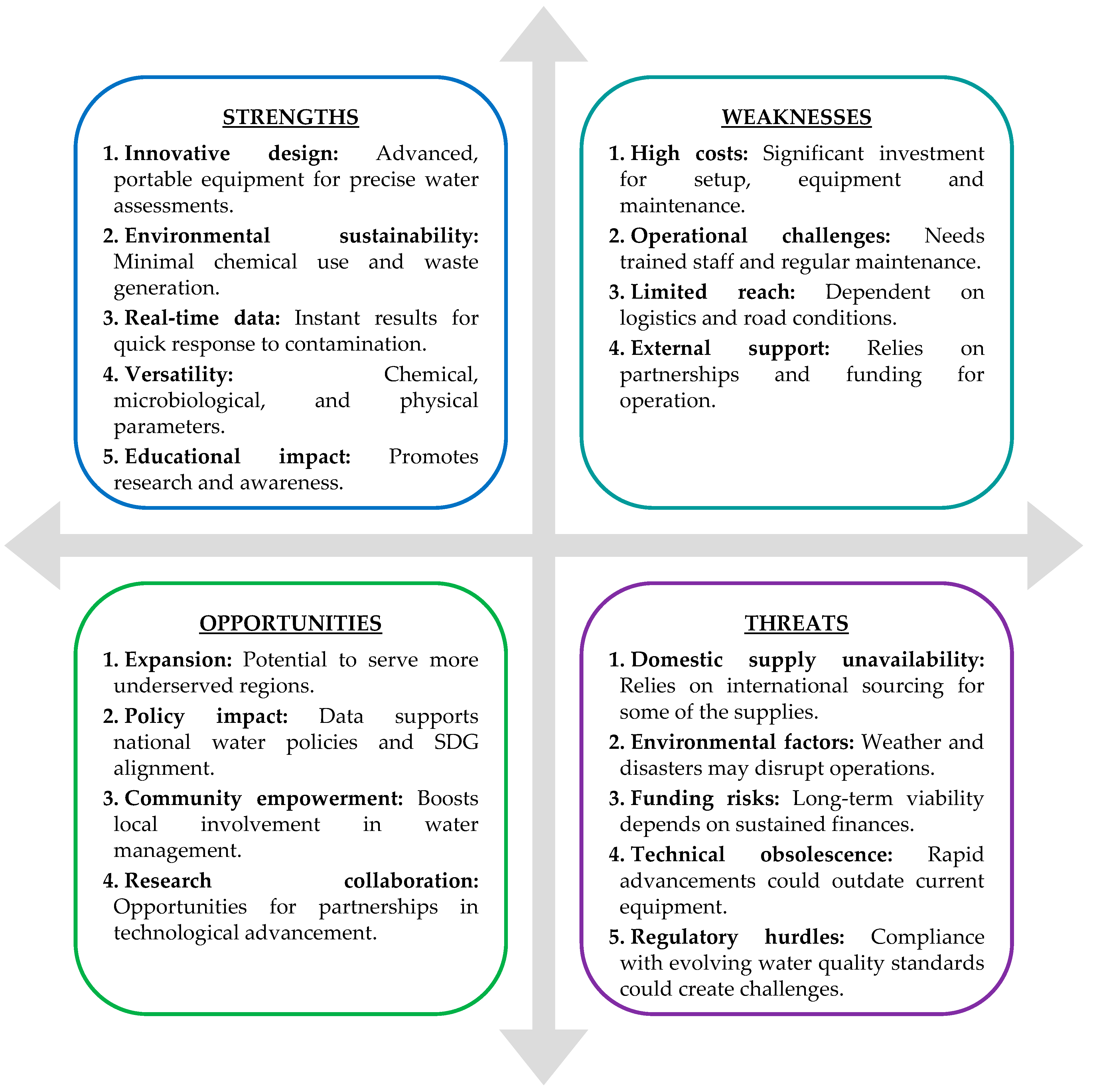
| Equipment | Model | Description |
|---|---|---|
| Portable gas mass chromatography | Torion T-9 portable GC/MS PerkinElmer, Inc.—Waltham, MA, USA | This equipment is essential for the evaluation of special organic pollutants such as pesticides. Its main feature, in addition to being portable, is that it uses the solid-phase microextraction technique, which does not require the use of any solvent or reagent. Capture occurs directly in the sample using special fibers that are then analyzed in the equipment. Unlike a conventional system, this technique is environmentally friendly and safer for operating technicians, and the results are obtained in a matter of minutes without requiring electrical connections or installation of gas lines and cylinders, as is the case with traditional systems [28,29]. |
| Portable X-ray fluorescence spectrophotometer | S2 PICOFOX—Fast Trace Element Analysis with XRF Bruker Nano GmbH—Berlin, Germany. Bruker AXS Inc.—Madison, WI, USA | This is required for in situ quantification of the presence of toxic heavy metals (e.g., lead, zinc, manganese, and arsenic) in water. Its main characteristic is that, unlike traditional laboratory systems, it does not require cooling by nitrogen lines or the use of a flame, which saves significant amounts of money and space. Its compact design makes it transportable, and its detection limits are on the order of ppb, which makes it suitable for trace analysis. It is capable of determining elements from sodium to uranium in a single reading without requiring the use of hazardous chemical compounds during the process, which makes it suitable for field work within the mobile laboratory [30,31]. |
| Portable microbiological laboratory | Potalab® + (M) Advanced Portable Water Quality Laboratory (Microbiological) Palintest—Erlanger, KY, USA | Microbiological analyses are often the most critical to determining the potability or contamination of water. However, they are also among the most delicate due to the risk of sample alteration during transport and the short shelf-lives of samples before being incubated. This system solves these drawbacks because it has everything necessary for micro-biological analysis, including sample collection equipment and two independently built-in battery-operated incubators that make it possible to immediately start the microbiological analysis of samples in the mobile laboratory without having to wait for the samples to arrive at a distant laboratory [32,33]. Samples can be stored for up to 24 h before the analysis. Once the analysis starts, the samples are first incubated for 18 h. After incubation, a colony-forming unit (CFU) count is performed to assess the microbial concentration in the sample. This process ensures accurate and reliable results while maintaining the integrity of the samples during transport and storage. |
| Portable spectrophotometer | DR1900 Portable Spectrophotometer—HACH, Loveland, CO, USA | Through the use of spectrophotometry, more than 150 tests are measured at technical discretion using pre-calibrated tubes that save space, time, and sample preparation tasks by only requiring the introduction of an aliquot of water to the corresponding tube and a reading on the spectrophotometer. This offers the advantages of minimal waste generation and the elimination of the need for calibration curves, which are indispensable in the mobile laboratory [16,34]. |
| Portable turbidimeter | 2100Q Portable Turbidimeter—HACH, Loveland, CO, USA | The 2100Q Portable Turbidimeter is ideal for use in the field. It is easy to carry around and take multiple measurements from various collection points in your treatment process [35,36,37,38]. |
| Digital titration | DREL 2800 Water Quality Laboratories—HACH, Loveland, CO, USA | Hand-held titrators with cartridges that do not require direct handling of acids or bases, enhancing the safety of the technicians within the mobile laboratory [16,39]. |
| Compact biochemical oxygen demand (BOD5) | BODTrak II Respirometric BOD Apparatus—HACH, Loveland, CO, USA | BOD5 is very susceptible to change over time and temperature, so much so that the maximum time to perform the test is 24 h, which is often a limitation if the water sampling point is very distant from the laboratory. In the mobile laboratory, the compact BOD5 measurement system solves this problem by being a system in which a sample can be placed directly for incubation, as the levels of produced CO2 in the sample can be recorded constantly [37,40,41,42,43]. |
| Oil and grease analyzer | Environmental Express® StepSaver™ Complete Extraction Systems—Environmental Express, Inc., Charleston, SC, USA | The Environmental Express StepSaver is intended to be used for any type of Solid Phase Extraction (SPE) technique using an extraction disk. The StepSaver Systems have been created to perform SPE following the US EPA method [44] for oil and grease extractions [45,46,47]. |
| Portable weather station | Kestrel 5200 professional environmental meter—Nielsen-Kellerman, Boothwyn, PA, USA | The portable weather station can record humidity, temperature, barometric pressure, and wind speed. It is compact and can be placed on a mast above the mobile laboratory for continuous recording of meteorological data during sampling campaigns. As it is battery-operated and connects wirelessly with a Bluetooth connection, communication with the interior of the laboratory to record and evaluate the data is guaranteed [48,49,50,51,52]. |
| UTECH | Reglamento Técnico DGNTl-COPANIT 21-2019 | National Primary Drinking Water Regulations (EPA) | Directive (EU) 2020/2184 on the Quality of Water Intended for Human Consumption |
|---|---|---|---|
| Total coliforms | ✓ | ✓ | ✓ |
| Thermotolerant coliforms | ✓ | ✓ | ✓ |
| Intestinal enterococcus | * | * | ✓ |
| Color | ✓ | * | ✓ |
| Turbidity | ✓ | ✓ | ✓ |
| pH | ✓ | * | * |
| Free residual chlorine | ✓ | ✓ | * |
| Conductivity | ✓ | * | * |
| Total dissolved solids | ✓ | ✓ | * |
| Hardness | ✓ | * | * |
| Chloride | ✓ | * | ✓ |
| Sulphate | ✓ | * | ✓ |
| Nitrite | ✓ | ✓ | ✓ |
| Nitrate | ✓ | ✓ | ✓ |
| Minerals and heavy metals | ✓ | ✓ | ✓ |
| Organic compounds (pesticides and hydrocarbons) | ✓ | ✓ | ✓ |
| Parameter | Transportable X-Ray Fluorescence Spectroscopy | Bruker S2 PICOFOX |
|---|---|---|
| Measurement technology | EDX (Energy Dispersive X-ray Fluorescence) | TXRF (Total Reflection X-ray Fluorescence) |
| Supply | X-ray tube | X-ray with microfocus |
| Measuring range | ppm—% | ppb—% |
| Elemental range | C–U | Al–U |
| Sample Types | Solids, liquids, powders | Solids, liquids, powders |
| Weight (Kg) | 45 | 39 |
| Dimensions (cm) | 36 × 59 × 46 | 30 × 59 × 45 |
| Vacuum pump | Yes | No |
| Computer | Desktop PC, 27″ monitor, printer | Notebook |
| Location of use | Laboratory | Laboratory and field |
| Autosampler | 12 positions | 25 positions |
| Needs nitrogen | No | No |
| Refrigeration | Air | Air |
| Calibration Discs | Not included | As, Mn, Ni and multielemental |
| Installation and Training | Included | Included |
| Included Accessories | Two polypropylene cells, 10 mL polyethylene cells, general Xcell 8 mL | Disc cleaning house, 75 quartz discs, 500 acrylic discs, micropipettes and tips, PTFE cup, paper filters, reaction tube, washing machine bottles, mortar and pestle, minishaker, spatulas |
| Parameter | Bench Top GC-MS Simple Cuadrupole | GC-MS Torion T-9 |
|---|---|---|
| Sampling technique | Liquid injection | Solid phase microextraction |
| Column | 30 m capillary column | 5 m microcolumn |
| Detector | Simple cuadruplole | Toroidal ion trap |
| Detection limit | ppb | ppb |
| Sample types | Solids, liquids, powders, with previous extraction | Solids, liquids, powders, without previous extraction |
| Weight (kg) | 45 | 14.5 |
| Dimensions (cm) | 51.5 × 53.0 × 44.0 | 38.1 × 39.4 × 22.9 |
| External vacuum pump | Yes | No |
| Computer | PC | Laptop (optional) |
| Location of use | Laboratory | Laboratory, field |
| Autosampler | Yes | No |
| External helium supply | Yes | Yes (optional) |
| Power supply | 220 V | 115 V or DC battery operated |
| SDG | Key Targets | Key Indicators | UTECH Contribution |
|---|---|---|---|
| SDG 6: Clean Water and Sanitation | 6.1: By 2030, achieve universal and equitable access to safe and affordable drinking water. | 6.1.1: Proportion of population using safely managed drinking water services. | UTECH enhances access to safe drinking water by providing rapid, precise water quality testing in remote areas, identifying contaminants such as heavy metals, pesticides, and pathogens. This ensures that communities have reliable information on water safety, enabling timely interventions to ensure water safety and quality. |
| 6.3: Improve water quality by reducing pollution, eliminating dumping, and minimizing the release of hazardous chemicals. | 6.3.2: Proportion of bodies of water with good ambient water quality. | UTECH helps monitor and track pollution in Panama’s water bodies, identifying harmful chemicals and contaminants, such as agricultural runoff, that could impact human health. The data collected informs both local authorities and communities, contributing to water management efforts and pollution reduction. | |
| SDG 3: Good Health and Well-being | 3.9: By 2030, substantially reduce the number of deaths and illnesses from hazardous chemicals and air, water, and soil pollution. | 3.9.2: Mortality rate attributed to unsafe water, unsafe sanitation, and lack of hygiene. | UTECH’s ability to detect chemical and microbiological contaminants in drinking water contributes to reducing health risks such as gastrointestinal diseases or heavy metal poisoning. The lab’s real-time data provision allows for rapid response and preventive measures, potentially reducing morbidity and mortality associated with unsafe water. |
| SDG 4: Quality Education | 4.7: By 2030, ensure that all learners acquire the knowledge and skills needed to promote sustainable development. | 4.7.1: Extent to which education for sustainable development is mainstreamed. | UTECH promotes environmental education by engaging students and researchers in water quality projects. Its collaboration with academic institutions fosters the development of technical skills and knowledge in advanced water quality analysis, contributing to the promotion of sustainable practices in Panama. This hands-on learning approach supports the educational goals related to sustainable development. |
| SDG 9: Industry, Innovation, and Infrastructure | 9.5: Enhance scientific research, upgrade the technological capabilities of industrial sectors, and encourage innovation. | 9.5.1: Research and development (R&D) expenditure as a proportion of GDP. | UTECH’s implementation introduces cutting-edge technology and methods for water analysis, enhancing Panama’s capacity for scientific research and technological innovation. The mobile lab also promotes public and private sector collaborations in environmental monitoring, stimulating research and development in the water and sanitation sector. |
| SDG 13: Climate Action | 13.1: Strengthen resilience and adaptive capacity to climate-related hazards and natural disasters. | 13.1.2: Number of countries with national and local disaster risk reduction strategies. | UTECH enhances Panama’s ability to respond to climate-related water emergencies by providing rapid, on-site analysis of water quality during floods, droughts, or contamination events. The lab’s mobility ensures that vulnerable communities can access critical water testing services in times of crisis, contributing to disaster risk reduction strategies and climate resilience. |
| SDG 14: Life Below Water | 14.1: By 2025, prevent and significantly reduce marine pollution of all kinds, particularly from land-based activities. | 14.1.1: Index of coastal eutrophication and floating plastic debris density. | UTECH aids in monitoring the quality of water bodies that flow into Panama’s coastal regions. By detecting pollutants such as nutrients from agricultural runoff and industrial chemicals, UTECH supports efforts to prevent coastal eutrophication and marine pollution, contributing to the protection of marine ecosystems. |
| SDG 15: Life on Land | 15.1: Ensure the conservation, restoration, and sustainable use of terrestrial and inland freshwater ecosystems. | 15.1.2: Proportion of important sites for terrestrial and freshwater biodiversity that are covered by protected areas. | UTECH contributes to the sustainable management of freshwater ecosystems by providing vital data on the health and quality of inland water sources. Its monitoring activities inform conservation efforts and ensure the protection of water bodies that are crucial for biodiversity. |
Disclaimer/Publisher’s Note: The statements, opinions and data contained in all publications are solely those of the individual author(s) and contributor(s) and not of MDPI and/or the editor(s). MDPI and/or the editor(s) disclaim responsibility for any injury to people or property resulting from any ideas, methods, instructions or products referred to in the content. |
© 2025 by the authors. Licensee MDPI, Basel, Switzerland. This article is an open access article distributed under the terms and conditions of the Creative Commons Attribution (CC BY) license (https://creativecommons.org/licenses/by/4.0/).
Share and Cite
Guevara, J.E.O.; Broce, K.; Gómez Zanetti, N.A.; Henríquez, D.; Ellis, C.; Mack-Vergara, Y.L. The Impact of a Mobile Laboratory on Water Quality Assessment in Remote Areas of Panama. Sustainability 2025, 17, 7096. https://doi.org/10.3390/su17157096
Guevara JEO, Broce K, Gómez Zanetti NA, Henríquez D, Ellis C, Mack-Vergara YL. The Impact of a Mobile Laboratory on Water Quality Assessment in Remote Areas of Panama. Sustainability. 2025; 17(15):7096. https://doi.org/10.3390/su17157096
Chicago/Turabian StyleGuevara, Jorge E. Olmos, Kathia Broce, Natasha A. Gómez Zanetti, Dina Henríquez, Christopher Ellis, and Yazmin L. Mack-Vergara. 2025. "The Impact of a Mobile Laboratory on Water Quality Assessment in Remote Areas of Panama" Sustainability 17, no. 15: 7096. https://doi.org/10.3390/su17157096
APA StyleGuevara, J. E. O., Broce, K., Gómez Zanetti, N. A., Henríquez, D., Ellis, C., & Mack-Vergara, Y. L. (2025). The Impact of a Mobile Laboratory on Water Quality Assessment in Remote Areas of Panama. Sustainability, 17(15), 7096. https://doi.org/10.3390/su17157096












